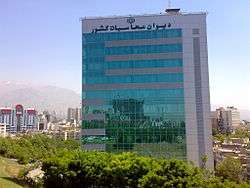Supreme Audit Court of Iran

| This article is part of a series on the |
| Politics of the Islamic Republic of Iran |
|---|
 |
| Government of Islamic Republic of Iran |
|
Supreme Councils |
|
Local governments |
|
|
|
The Supreme Audit Court of Iran (SAC) is a government agency of the Islamic Republic of Iran. Located in Tehran, it is supervised by the Iranian Parliament and dates back to 1906.
Articles 54 and 55 of the Constitution of the Islamic Republic of Iran define the objectives and responsibilities of SAC, the most important duty of the organization being the preparation of the government's Budget Liquidation Report, as specified by article 55 of the Constitution.[1]
The state body is tasked with controlling "financial operations and activities of all ministries, institutions, government companies and other organizations which in any manner whatsoever benefit from the state budget."[2]
Since 2010, SAC has been charged with supervising the Iranian Economic Reform Plan.[3] SAC also monitors the Oil Ministry’s deposits into the state treasury on a monthly basis.[4] It is also in charge of the supervision of the National Development Fund.
"$1 billion missing oil money"
In May 2009, SAC reported that 1 billion was missing from Oil Stabilization Fund. Iranian President Mahmoud Ahmadinejad says the issue of the 'missing' $1 billion from the country's currency reserve fund is in fact an "accounting error."[2] However, the claim prompted a firm response from SAC which rejected any talks of "accounting errors" and rebuked the government for providing "insufficient answers" in the case of the missing $1.058 billion oil money.[2]
SAC defended both methodology and accuracy of its work and revealed that there had been 1463 cases of infractions regarding the country's 2007-2008 budget.[2] According to SAC's report, illegal payments to some government officials accounted for a large part of the infractions while there were also cases in which the government had acted against the articles of the budget law.[5][6]
In December 2010, Supreme Audit Court (SAC) Director Abdolreza Rahmani Fazli said that the case was mentioned in a report presented to the Majlis and the report neither called it fraud nor said the money was missing, but only referred to it as "a deficit in the account".[7]
Babak Zanjani
According to head of Iran’s Supreme Audit Court Amin-Hossein Rahimi, Babak Zanjani’s role in the course of transferring the country’s oil revenues involved breach of law because he did not provide collateral for his multi-billion dollar oil contracts with the government.[8] As a consequence, Iran was not able to obtain a complete payment for the oil it sold following the international oil embargo.[9]
Criticism
According to Freedomhouse "SAC is little more than a ceremonial body because judges appointed by the regular judiciary often overturn its verdicts".[10] They are also not permitted to inspect any of the finances related to the Revolutionary Guards, which is where most of the corruption within the country is believed to originate.
Asked whether Transparency International's recent report on administrative corruption in Iran corresponds to the findings of the Supreme Audit Court, SAC Director Fazli said the report is based on criteria that the SAC does not recognize. "This does not mean that Iran rejects the report and the country should make efforts to fulfill their criteria," he added.[7]
See also
- General Inspection Office (Iran)
- History of the Islamic Republic of Iran
- President Ahmadinejad
- Central Bank of Iran
- Iranian Economic Reform Plan
- Bonyad
- Ministry of Intelligence of Iran
- Privatization in Iran
- Economy of Iran
- Islamic Revolutionary Court
Further reading
- (English) Mandates of the Supreme Audit Court of Iran
- Country Report "Anticorruption and Transparency" - Iran (2007) - Freedom House
- President calls for concord between supervisory and executive organs
External links
- Supreme Audit Court - Linked to the Iranian Parliament
- General Inspection Office - Linked to the Judiciary of Iran
- Iran Audit Organization - Linked to the Ministry of Economic and Finance Affairs
References
- ↑ "دیوان Ù…Øاسبات کشور" (PDF). Dmk.ir. Retrieved 2013-08-01.
- 1 2 3 4 "No Operation". Presstv.com. Retrieved 2013-08-01.
- ↑ "No Operation". Presstv.com. Retrieved 2013-08-01.
- ↑ Archived October 12, 2012, at the Wayback Machine.
- ↑ Archived April 19, 2009, at the Wayback Machine.
- ↑ "No Operation". Presstv.com. Retrieved 2013-08-01.
- 1 2 "Iran: Oil Revenues Monitored Monthly". Zawya. 2009-12-10. Retrieved 2013-08-01.
- ↑ http://presstv.com/detail/2014/03/11/354193/iran-sends-teams-abroad-over-fraud-case/
- ↑ http://www.payvand.com/news/14/feb/1135.html
- ↑ Stephen Fairbanks. "Iran". Freedom House. Retrieved 2013-08-01.